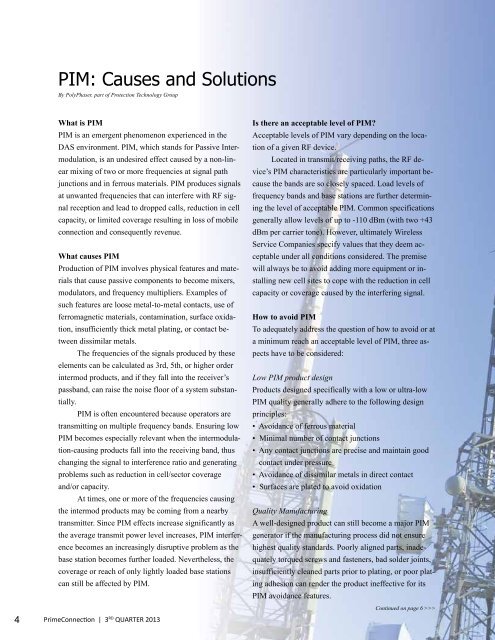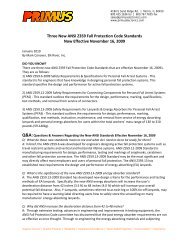3RD QUARTER 2013 - Primus Electronics Corporation
3RD QUARTER 2013 - Primus Electronics Corporation
3RD QUARTER 2013 - Primus Electronics Corporation
Create successful ePaper yourself
Turn your PDF publications into a flip-book with our unique Google optimized e-Paper software.
PIM: Causes and SolutionsBy PolyPhaser, part of Protection Technology GroupWhat is PIMPIM is an emergent phenomenon experienced in theDAS environment. PIM, which stands for Passive Intermodulation,is an undesired effect caused by a non-linearmixing of two or more frequencies at signal pathjunctions and in ferrous materials. PIM produces signalsat unwanted frequencies that can interfere with RF signalreception and lead to dropped calls, reduction in cellcapacity, or limited coverage resulting in loss of mobileconnection and consequently revenue.What causes PIMProduction of PIM involves physical features and materialsthat cause passive components to become mixers,modulators, and frequency multipliers. Examples ofsuch features are loose metal-to-metal contacts, use offerromagnetic materials, contamination, surface oxidation,insufficiently thick metal plating, or contact betweendissimilar metals.The frequencies of the signals produced by theseelements can be calculated as 3rd, 5th, or higher orderintermod products, and if they fall into the receiver’spassband, can raise the noise floor of a system substantially.PIM is often encountered because operators aretransmitting on multiple frequency bands. Ensuring lowPIM becomes especially relevant when the intermodulation-causingproducts fall into the receiving band, thuschanging the signal to interference ratio and generatingproblems such as reduction in cell/sector coverageand/or capacity.At times, one or more of the frequencies causingthe intermod products may be coming from a nearbytransmitter. Since PIM effects increase significantly asthe average transmit power level increases, PIM interferencebecomes an increasingly disruptive problem as thebase station becomes further loaded. Nevertheless, thecoverage or reach of only lightly loaded base stationscan still be affected by PIM.Is there an acceptable level of PIM?Acceptable levels of PIM vary depending on the locationof a given RF device.Located in transmit/receiving paths, the RF device’sPIM characteristics are particularly important becausethe bands are so closely spaced. Load levels offrequency bands and base stations are further determiningthe level of acceptable PIM. Common specificationsgenerally allow levels of up to -110 dBm (with two +43dBm per carrier tone). However, ultimately WirelessService Companies specify values that they deem acceptableunder all conditions considered. The premisewill always be to avoid adding more equipment or installingnew cell sites to cope with the reduction in cellcapacity or coverage caused by the interfering signal.How to avoid PIMTo adequately address the question of how to avoid or ata minimum reach an acceptable level of PIM, three aspectshave to be considered:Low PIM product designProducts designed specifically with a low or ultra-lowPIM quality generally adhere to the following designprinciples:• Avoidance of ferrous material• Minimal number of contact junctions• Any contact junctions are precise and maintain goodcontact under pressure• Avoidance of dissimilar metals in direct contact• Surfaces are plated to avoid oxidationQuality ManufacturingA well-designed product can still become a major PIMgenerator if the manufacturing process did not ensurehighest quality standards. Poorly aligned parts, inadequatelytorqued screws and fasteners, bad solder joints,insufficiently cleaned parts prior to plating, or poor platingadhesion can render the product ineffective for itsPIM avoidance features.4PrimeConnection | 3 RD <strong>QUARTER</strong> <strong>2013</strong>Continued on page 6 >>>










